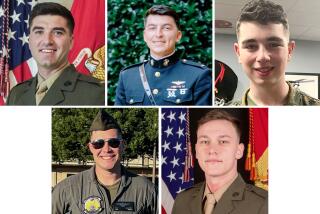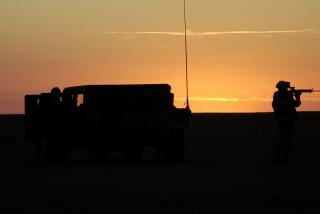‘K-Day’ Nears, But No One Writing ‘Last Letter Home’ : Troops: El Toro and Tustin airmen focus on future. They’re not hungry to fight; they just want to finish.
- Share via
EASTERN SAUDI ARABIA — Standing at an airfield bristling with helicopter gunships and the heavy, twin-rotored choppers that ferry troops into battle, the commander of Marine air power in the Persian Gulf said Friday that his forces are ready to move Jan. 15.
“I think that as you talk to people, you’ll see the Marines are ready to go . . . and as each day goes on, we’re more ready,” said Maj. Gen. Royal N. Moore Jr., architect of a buildup of Marine aircraft in the gulf that he said was “unparalleled in history.” Moore is commander of the 3rd Marine Aircraft Wing at El Toro.
With the deadline for an Iraqi pullout from Kuwait just days off, Moore said his aviators were ready to fight “on the 15th,” or whenever the President decides to take military action against Iraq.
“We came to do a job and will not leave until it is done as directed,” said Moore.
Moore’s statement came as officials confirmed that the Marine general had moved his headquarters from an unnamed outside country to the Saudi airfield, putting him closer to the Kuwaiti border and enabling him to better coordinate the use of Marine aircraft in the event of war.
As Moore spoke briefly with reporters, Sea Cobra helicopter gunships with loaded rocket pods lifted off and headed north toward Kuwait while mechanics inspected and cleaned the engines of rows of CH-46 Sea Knight and CH--53D Sea Stallion transport helicopters.
Inside a nearby building, squadrons of Marine pilots with their helmets at the ready met for briefing sessions on weather conditions and other classified matters. At warehouses near the flight line, trucks piled high with military hardware and spare parts were unloaded under heavy armed guard.
Moore conceded that problems remain with the fine, powdery desert sand wearing down helicopter engines and parts.
But he said that most of those problems have been resolved, and after five months of training in the desert he is confident that Marine aircraft would perform well in any battle against Iraq.
A veteran helicopter and jet pilot who flew 287 combat missions in Vietnam, Moore left his post at El Toro shortly after the Aug. 2 Iraqi invasion of Kuwait and began assembling an air-assault force that now includes hundreds of fighter jets, helicopters, transport planes and observation aircraft.
At his disposal in the gulf are squadrons of F/A-18 Hornet jet fighters, including about 24 from El Toro, and AV-8B Harrier jump jets from Yuma, Ariz.
The Camp Pendleton-based Cobras, equipped with 20-millimeter guns and laser-guided Hellfire missiles, are thrown into battle to knock out enemy tanks and provide close air support for advancing ground troops.
Transported here from Tustin, the Sea Knights are being used to ferry troops, heavy weapons and supplies, while the Sea Stallions haul heavy equipment and artillery.
At the airfield, the mood among pilots, crewmen and support personnel was upbeat as they talked of what is known here as “K-Day,” short for “Kuwait Day,” the day when President Bush orders U.S. forces to move against the estimated half-million Iraqi troops occupying Kuwait.
“I can assure you there is a heightened sense of anxiety here,” said Lt. Col. Larry Underwood of San Juan Capistrano, executive officer of HMM-161, a squadron of the Tustin-based Sea Knights. “You can see it in the men. There is a kind of quiet confidence. They’re not hungry for a fight. They just want to get it over with.”
“For us, every day has been K-Day,” added Capt. Larry Buynak, an Irvine father of four who is with the same squadron. “We never know from one day to the next if this is going to be the day, if we’re going to look up in the sky and see Iraqi rockets headed this way. People are thinking about it, but they are focused on their missions. No one is writing that last letter home.”
Buynak noted that Tuesday, the deadline imposed by the U.N. for an Iraqi withdrawal, will fall on Tuesday--the 40th anniversary of the founding of his helicopter squadron.
“The HMM-161 was the first tactical helicopter squadron ever created, and it was the first to be used for a mass helicopter resupply mission,” he said. “Now we may have another first coming.”
With hopes for a diplomatic settlement fading, the prospect of war has given pause to helicopter pilot Capt. P. E. Karle, 34, of Laguna Hills.
“I’ve never been in a war, and I don’t think anyone is ready for combat,” Karle said. “The only people who aren’t scared are either crazy or lying.
“We’ve been here since Aug. 17, and we’ve flown a lot of missions and trained hard. We just want to do it and get home.”
Karle said he already had flown more than 50 medical evacuation missions in Saudi Arabia since August, plucking from the field troops who have accidentally shot themselves, been bitten by scorpions, or been hurt in other accidents.
He said he expected that if fighting breaks out, he would be taking his Sea Knight helicopter into the midst of battle to ferry out the wounded.
Capt. Woody Narvaez, another Sea Knight pilot from Laguna Hills, said the approach of the deadline Tuesday had left the squadron with a determination to concentrate on what may lie ahead.
“If nothing else, it focuses our attention,” said Narvaez, 30, who has two young daughters at home. “We’re not at each other’s throats any more. We all know what’s coming.”
More to Read
Sign up for Essential California
The most important California stories and recommendations in your inbox every morning.
You may occasionally receive promotional content from the Los Angeles Times.













